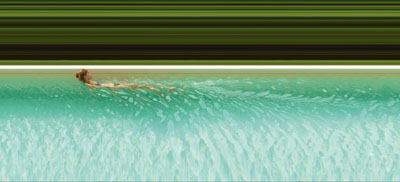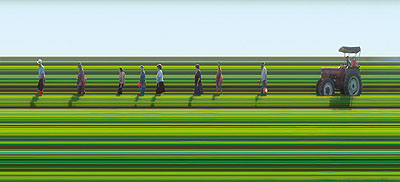
Courtesy aplanat galerie für fotografie, Hamburg
Jay Mark Johnson »
TEMPO LINEARE
Exhibition: 29 Sep – 28 Oct 2007

Courtesy aplanat galerie für fotografie, Hamburg
Jay Mark Johnson's remarkable large-scale photographs and photo-collages are about space and time, and paradoxically, in the case of the images in this exhibition, about space and timelessness. He takes subjects that have engaged the imagination of artists for centuries—the bustle of the piazza, the routines of the countryside—and transforms them, employing the technology of the computer age, into visual narratives that astonish the eye. In this newly-minted world, the familiar co-exists fruitfully with the pictorially startling. A horse is led across an abstract landscape made up of attenuated filaments of vivid color. A swimmer advances through water that seems to refract light both optically and digitally. The technique Johnson uses to produce these images is known as slit-scan photography. In the past it has been employed for scientific experiments, and also to produce optical effects in films such as 2001: A Space Odyssey. (For two decades, Johnson was a visual effects supervisor in the movie industry.) Slit-scan photography involves prolonged exposures in which a frame of film, or an array of digital sensors, is sensitized--over a period which might amount to several seconds--by a narrow, moving band of light. All of the movement that occurs in front of the lens during this period is synthesized into a single image, so that the resulting photograph incorporates the dimension of time, in effect freezing it. No matter how skillfully applied, of course, technology does not guarantee an outcome that deserves to be described as art. That requires vision, and Johnson's is fully apparent in the ten images of Cetona and its surroundings that make up this exhibition. These photographs do not present their subject matter in the manner of a postcard, or an illustration in a travel brochure. Rather they isolate aspects of a particular scene—pedestrians and automobiles, for example, or a man pushing a wheelbarrow—and present them against a background that retains only vestiges of figuration: the merest hint of a roadway, a horizon line, a panoramic expanse of sky. In short, Jay Johnson employs digital technology to focus attention on a few essential elements of the subject which become the focus of the image. This is the opposite of what we find in the photographs of artists such as Andreas Gursky and Thomas Struth, who produce comparably large-scale works that draw their strength from the exhaustive accumulation of detail: images in which the point is that everything is shown, nothing is excluded. Johnson, by contrast, uses the slit-scan technique to simplify through selectivity, offering the viewer with an edited version of the subject rather than confronting him with a visual catalog of its components. In the present exhibition, this simplification is perhaps most apparent in the image of a tractor seen as a distant object in a landscape that has been reduced to a non-figurative array of parallel horizontal lines. All recognizable pictorial information has been eliminated, except for the tractor itself which exists as a conventional photographic representation. Its smallness against the immensity of the picture plane gives the image a poignancy that is heightened by the dialogue set up between illusion and abstraction. Selectivity is equally important in more complex images such as the pair in which people and animals, cars and trucks move from right to left along a street without recognizable features, their shadows cast this way and that in a manner that can be explained only by the seemingly perverse optical characteristics dictated by slit-scan technology. Johnson describes these two images as photo-collages, an acknowledgement of the fact that he has used digital means to combine figures borrowed from different exposures. Photo-collage is in fact a very appropriate term in that the results actually suggest something that might have been assembled from figures clipped from conventional photographs and glued to a drawn or painted background created with the help of a ruler, or masking tape. Each of these two images contains more than a score of figures, not counting dogs, yet the process of simplification remains apparent in the lack of topographical context which encourages the viewer to focus attention on the procession of people, pets, and automobiles, the latter rendered toy-like by the camera.